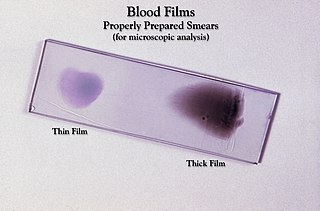Related Research Articles

Pathology is the study of the causes and effects of disease or injury. The word pathology also refers to the study of disease in general, incorporating a wide range of biology research fields and medical practices. However, when used in the context of modern medical treatment, the term is often used in a narrower fashion to refer to processes and tests that fall within the contemporary medical field of "general pathology", an area which includes a number of distinct but inter-related medical specialties that diagnose disease, mostly through analysis of tissue and human cell samples. Idiomatically, "a pathology" may also refer to the predicted or actual progression of particular diseases, and the affix pathy is sometimes used to indicate a state of disease in cases of both physical ailment and psychological conditions. A physician practicing pathology is called a pathologist.

Anatomical pathology (Commonwealth) or Anatomic pathology (U.S.) is a medical specialty that is concerned with the diagnosis of disease based on the macroscopic, microscopic, biochemical, immunologic and molecular examination of organs and tissues. Over the last century, surgical pathology has evolved tremendously: from historical examination of whole bodies (autopsy) to a more modernized practice, centered on the diagnosis and prognosis of cancer to guide treatment decision-making in oncology. Its modern founder was the Italian scientist Giovan Battista Morgagni from Forlì.
Fritz Köberle was an Austrian-Brazilian physician, pathologist and scientist, discoverer of the neurogenic mechanism of the chronic phase of Chagas disease, a human parasitic disease caused by Trypanosoma cruzi, a protozoan.

Sidney Farber was an American pediatric pathologist. He is regarded as the father of modern chemotherapy for his work using folic acid antagonists to combat leukemia, which led to the development of other chemotherapeutic agents against other malignancies. Farber was also active in cancer research advocacy and fundraising, most notably through his establishment of the Jimmy Fund, a foundation dedicated to pediatric research in childhood cancers. The Dana–Farber Cancer Institute is named after him.

The Johns Hopkins University School of Medicine (JHUSOM) is the medical school of Johns Hopkins University, a private research university in Baltimore, Maryland. Founded in 1893, the School of Medicine shares a campus with the Johns Hopkins Hospital and Johns Hopkins Children's Center, established in 1889. It has consistently ranked among the top medical schools in the United States in terms of the number/amount of research grants/funding awarded by the National Institutes of Health, among other measures.

Clinical pathology is a medical specialty that is concerned with the diagnosis of disease based on the laboratory analysis of bodily fluids, such as blood, urine, and tissue homogenates or extracts using the tools of chemistry, microbiology, hematology, molecular pathology, and Immunohaematology. This specialty requires a medical residency.

Surgical pathology is the most significant and time-consuming area of practice for most anatomical pathologists. Surgical pathology involves gross and microscopic examination of surgical specimens, as well as biopsies submitted by surgeons and non-surgeons such as general internists, medical subspecialists, dermatologists, and interventional radiologists.
Chronic eosinophilic leukemia is a form of cancer in which too many eosinophils are found in the bone marrow, blood, and other tissues. Most cases are associated with fusion genes.

The Annual Review of Pathology: Mechanisms of Disease is a peer-reviewed academic journal that publishes an annual volume of review articles relevant to pathology. It was established in 2006 and is published by Annual Reviews. Its co-editors have been Jon C. Aster, Mel B. Feany, and Jayanta Debnath since 2021. As of 2022, Journal Citation Reports gives the journal a 2021 impact factor of 32.350, ranking it first of 77 journal titles in the category "Pathology".
Christopher D. M. Fletcher is a British pathologist who has written more than 500 peer reviewed articles and was a chairman of the World Health Organization's Working Group on the Pathology and Genetics of Tumours of Soft Tissue and Bone. He graduated from London's St. Thomas's Hospital Medical School and got his M.D. degree from the University of London in 1991. Later on, he became a postdoc at the Royal College of Pathologists, from which he also graduated in 1988. He was trained at St Thomas' Hospital and was president of the Association of Directors of Anatomic and Surgical Pathology from 2003 to 2006. Currently he is a Professor of Pathology at Harvard Medical School, president of both the Arthur Purdy Stout Society and the International Society of Bone & Soft Tissue Pathology and is also a surgical pathologist at the Brigham and Women's Hospital. He also works for the Dana–Farber Cancer Institute in Boston, Massachusetts as chief of onco-pathology.
Abul K. Abbas is an American pathologist at University of California San Francisco where he is Distinguished Professor in Pathology and former chair of its Department of Pathology. He is senior editor of the pathology reference book Robbins and Cotran Pathologic Basis of Disease along with Vinay Kumar, as well as Basic Immunology, and Cellular & Molecular Immunology. He was editor for Immunity from 1993-1996, and continues to serve as a member of the Editorial Board. He was one of the inaugural co-editors of the Annual Review of Pathology: Mechanisms of Disease for issues from 2006-2020. He has published nearly 200 scientific papers.
Sir Stephen Townley Holgate, is a British physician who specializes in immunopharmacology, respiratory medicine and allergies, and asthma and air pollution, based at the University of Southampton and University Hospital Southampton NHS Foundation Trust, UK.
EmanuelRubin was an American pathologist known for his contributions to the study of liver disease, cardiomyopathy and alcoholic tissue injury, and as the editor of Rubin’s Pathology, a medical textbook first published in 1988, now in its eighth edition.
Mel B. Feany is an American neuropathologist and geneticist at Brigham and Women's Hospital who researches neurodegenerative disease. She is a co-editor of the Annual Review of Pathology: Mechanisms of Disease.

James R. Downing is an American pediatric oncologist and executive. He is the president and chief executive officer of St. Jude Children's Research Hospital.
Stephen Joseph Galli is an American pathologist who researches mast cells and basophils. He is a member of the National Academy of Medicine, a recipient of the National Institutes of Health MERIT Award, and former co-editor of the Annual Review of Pathology: Mechanisms of Disease.
Jayanta Debnath is an American physician who specializes in pathology. His research focuses on autophagy as it relates to cancer. He is the chair of the University of California, San Francisco department of pathology and a co-editor of the Annual Review of Pathology: Mechanisms of Disease.
Michael Joseph Mina is an American epidemiologist, immunologist and physician. He was formerly an Assistant Professor of Epidemiology & Immunology and Infectious Diseases at Harvard T.H. Chan School of Public Health, Assistant Professor of Pathology at Brigham and Women's Hospital, Harvard Medical School, and currently Chief Medical Officer at eMed.
The Association for Molecular Pathology is a professional association of individuals serving patients through molecular diagnostics testing. Founded in 1995, the Association has more than 2,800 members in over 50 countries.
References
- 1 2 3 "Pulling Back the Curtain: Richard Aster, MD, and Jon Aster, MD, PhD". ASH Clinical News. 1 June 2020. Retrieved 19 January 2021.
- ↑ "Jon Aster". Brigham Research Institute. Retrieved 19 January 2021.
- ↑ "People". Aster Laboratory. Retrieved 19 January 2021.
- ↑ Pai, Sanjay A. (2017). "Review of Annual Review of Pathology: Mechanisms of Disease, 2016". Current Science. 112 (11): 2327–2329. ISSN 0011-3891. JSTOR 26163840.
- ↑ "Jon C. Aster". Textbooks For Life. Retrieved 24 March 2023.
- ↑ Bunn, H. Franklin; Aster, Jon C., eds. (17 December 2010). "Preface". Pathophysiology of Blood Disorders. The McGraw-Hill Companies, Inc. ISBN 978-0-07-171377-1.
- ↑ Aster, Jon C.; Pozdnyakova, Olga; Kutok, Jeffery L., eds. (2012). Hematopathology. Elsevier Health Sciences. p. 11. ISBN 9781455737581.
- ↑ Jon Aster's Publications on Google Scholar https://scholar.google.ca/citations?user=VaJfIfIAAAAJ&hl=en